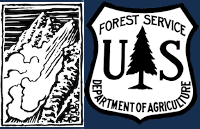Two skiers were ascending a northeast-facing avalanche path on the northernmost ridgeline of Mount Blackmore around 1 PM when they triggered a large, dry slab avalanche that failed 3 feet deep, 150 feet wide, and ran 500 feet vertical. Debris piled up 4-8 feet deep. This photo captures the first area to avalanche on the climber's right side of the path. Photo: GNFAC
Northern Gallatin
Two skiers were ascending a northeast-facing avalanche path on the northernmost ridgeline of Mount Blackmore around 1 PM when they triggered a large, dry slab avalanche that failed 3 feet deep, 150 feet wide, and ran 500 feet vertical. Debris piled up 4-8 feet deep. One skier was carried to the bottom left of the runout zone. Photo: GNFAC
Two skiers were ascending a northeast-facing avalanche path on the northernmost ridgeline of Mount Blackmore around 1 PM when they triggered a large, dry slab avalanche that failed 3 feet deep, 150 feet wide, and ran 500 feet vertical. Debris piled up 4-8 feet deep. One skier was carried to the bottom left of the runout zone. Photo: GNFAC
Two skiers were ascending a northeast-facing avalanche path on the northernmost ridgeline of Mount Blackmore around 1 PM when they triggered a large, dry slab avalanche that failed 3 feet deep, 150 feet wide, and ran 500 feet vertical. Debris piled up 4-8 feet deep. Photo: GNFAC
Forecast link: GNFAC Avalanche Forecast for Wed Mar 20, 2024GNFAC Avalanche Forecast for Thu Mar 21, 2024GNFAC Avalanche Forecast for Fri Mar 22, 2024GNFAC Avalanche Forecast for Sat Mar 23, 2024GNFAC Avalanche Forecast for Sun Mar 24, 2024
Deep Slab Avalanche near Mt Blackmore
Two skiers were ascending a northeast-facing avalanche path on the northernmost ridgeline of Mount Blackmore around 1 PM when they triggered a large, dry slab avalanche that failed 3 feet deep, 150 feet wide, and ran 500 feet vertical. Debris piled up 4-8 feet deep. The avalanche failed on weak, faceted snow near the base of the snowpack.
As the group was about halfway up the avalanche path, they saw a small slide initiate to their right and then they heard a loud boom as the rest of the slope collapsed 250 feet above them. The skier lower on the path sprinted to the left into the trees to avoid getting caught. The second skier was 30 higher on the slope. He attempted to run off the slope but was unable to avoid getting captured. He was carried to the bottom of the avalanche path, got submerged in the snow, but thankfully came to rest on the surface. His partner initiated a beacon search and called his name, quickly finding him on top of the avalanche debris. The skier sustained significant injuries. They called 911 and Gallatin Country Sheriff Search and Rescue initiated a response with the Helicopter team. The two skiers worked to address injuries while awaiting rescue. GCSAR inserted a team with a helicopter that provided medical treatment and transported both the injured and uninjured skiers. The GNFAC was on scene to evaluate the scene for hazards to the rescue team.
My partner and I were approaching Responsible FamilyMan via Avalanche Gulch early yesterday morning (3/18), and once we broke through the trees into the runout zone, we stumbled across a pretty large wet avalanche debris field. The debris terminated within ~50 yards of the max runout zone. Photo: R. Parsons
Forecast link: GNFAC Avalanche Forecast for Sat Mar 23, 2024
My partner and I were approaching Responsible Family Man via Avalanche Gulch early yesterday morning (3/18), and once we broke through the trees into the runout zone, we stumbled across a pretty large wet avalanche debris field. The debris terminated within ~50 yards of the max runout zone. Photo: R. Parsons
Wet slide in Avalanche Gulch
Poor snow structure on Saddle Peak
On the drive up we could see a wet slide from yesterday that occurred in Argentina bowl, human triggered. We also got a report of a wet slide in St Lawrence path in Truman Gulch (not big). We toured along the ridge to the summit of Saddle. By 1000 the snow was softening. We dug below the first cliff band and found 7' of snow, the bottom 2' consisting of weak facets. A Deep Tap Test showed a clean shear at this interface. An avalanche could be triggered by 3 ways: more load from snowfall or wet avalanche debris, melt-water percolating through the snowpack to the facets, or human triggering from a thin spot.
By 1100 the snow was getting wet and punchy at lower elevations. Loose wet slides could trigger dry slab avalanches, a proposition we did not want to hang around for.
